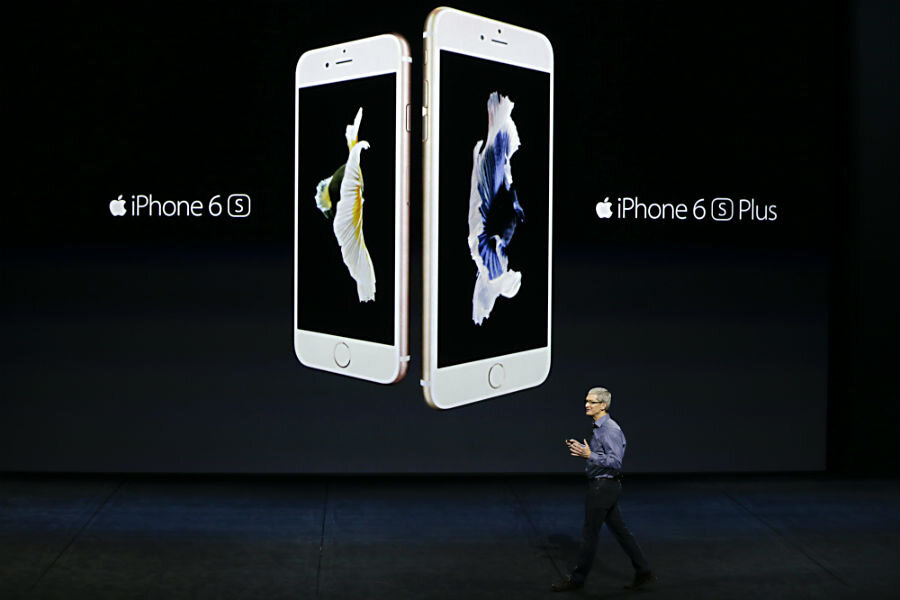Has Apple hit 'peak iPhone'? Not yet, says Tim Cook.
Loading...
In the wake of unsubstantiated comments related to issues with Apple’s iPhone supply chain and peaking sales, the technology company’s strong first quarter should demonstrate the iPhone has still got legs.
Reports saying that Apple would reduce its iPhone production by about 30 percent were cause for alarm for some, who feared such a drastic cut indicated that iPhone sales were going to tank. But these estimates missed the mark, with actual production cuts in December coming in about 10 percent.
But some investors still foresee a sales decline, after it was reported that Morgan Stanley expects a 6 percent decrease in iPhone sales during the 2016 financial year.
If Morgan Stanley's outlook comes true, it would mark the first time since the iPhone’s launch that sales actually decreased.
While some years have not seen the growth of others, Apple has yet to report a negative change in sales year over year. But Morgan Stanley research director Katy Huberty, in her report, wrote that "higher prices in international markets and maturing smartphone penetration in developed markets weighs on upgrades and new user growth,” according to Business Insider.
These sales expectations are part of the reason Apple’s stock has seen a recent downturn, although the low stock evaluations have led the company to buy back billions of the more than 100 million shares of Apple currently on the market. And the supply chain data used in the Morgan Stanley report could be taken out of context, as the order reduction estimates may be more due to excess stock than a lack of consumer interest; Huberty anticipates the possibility of “upward revisions” on the iPhone’s sales if the sales play out as planned.
Coming off of another robust holiday season, and its biggest financial quarter yet, the case can be made that Apple's iPhone is poised to pull off yet another strong year in sales. This comes as sales for Android and Windows smartphones – Apple’s main iPhone competitors – could be dropping off, with those products’ users switching to iOS devices at a higher rate than ever and those phones not selling as well as they once did.
Apple’s first quarter, which ended in December, was its most successful for iPhone sales ever, according to Statista. While iPhone sales have gradually risen since the product first debuted in 2007, the first quarter in the company’s 2015 and 2016 fiscal years saw more than 74 million units sold. Those numbers suggest that demand is still present among consumers, and that a massive sales downturn is unlikely.
Drop offs of some kind are to be expected every year coming off the holiday season. A second-quarter sales dip has been the standard since 2012, and is not necessarily a sign of future declines. In line with typical sales for the time period, supply of Apple’s smartphones is also expected to drop but probably does not herald the death of the iPhone, as some have forecast.
“We do think that iPhone units will decline in the quarter. We don't think that they'll decline to the level that you're talking about,” Apple Chief Executive Officer Tim Cook said at an earnings call, in response to questions surrounding a reduction in parts production.
Apple’s sales are cyclical, and have exhibited the same trends over the past several years. Since 2012, sales have fallen through the second and third quarters of each year and risen slightly in the fourth, before jumping back up at the start of the next fiscal year (Sept-Dec.).
This pattern, in accordance with Apple’s usual unveiling of new products in the fall and holiday sales, also suggests a positive outlook for the tech giant. Despite ideas that “everyone who wants an iPhone already has one,” and what some have called “peak iPhone,” there is a case to be made that iPhone sales have not topped out. With a new generation of iPhones potentially launching later this year and Android users abandoning the platform at high rates, demand should roughly keep pace with past sales, says Apple.
“We recorded the highest rate on record for Android switchers last quarter at 30 percent. We also look at the number of people that have upgraded, that were in the install base prior to iPhone 6 and 6 Plus, and that number is in the low 30 percentages, so we feel like we have a very open field in front of us,” Cook said in September.
Apple also plans to grow its capital expenditures across the board, from the $11.2 billion spent on data centers, building facilities and stores, and more in 2015, to more than $15 billion this coming year. That projection, good for a nearly 34 percent increase, is a sign of the company’s continued expansion and is far above the $2 billion in capital expenditures it reported five years ago. Apple also still has around $200 billion in cash available, which could help mitigate any sales drops that may occur.
“Beyond the short-term volatility, we remain very confident... and we are maintaining our investment plans,” Cook said in a call with investors, per The Washington Post. “Despite the economic challenges all over the world, Apple remains incredibly strong.”







